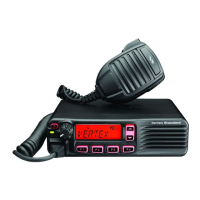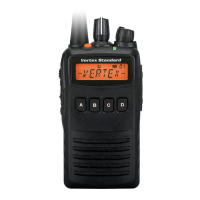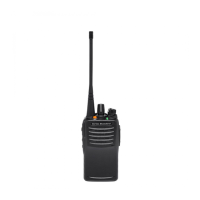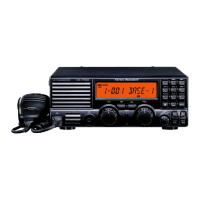7VX-4500/-4600 Series VHF FM Transceiver Service Manual
3. Transmitter System
3-1. Mic Amplifier
The AF signal from microphone jack J2001 (VX-4500) or J3001
(VX-4600) is amplified with microphone amplifier in Q1010
(FQ0801), is amplified a second time after microphone selec-
tion switch Q1010 (FQ0801), and passes through microphone
gain volume in Q1010 (FQ0801). The control from the CPU
passes output and it passes a pre-emphasis circuit. When an
option unit is installed, the AF signal from Q1010 (FQ0801)
pin 38 goes through the option unit, and returns to Q1010
(FQ0801) pin 39. When an option unit isn't installed, Q1010
(FQ0801) is inputted to the pre-emphasis circuit. The signal
passes the limiter and splatter filter of Q1010 (FQ0801), and
is adjusted by maximum deviation adjustment volume. The ad-
justed low frequency signal ingredient is amplified by Q1047
(NJM2904V), added modulation terminal of TCXO (X1002),
the FM modulation is made by reference oscillator.
The high frequency signal ingredient is amplified, and adjusted
the level by volume Q1010 (FQ0801) to make frequency bal-
ance between low frequency. After that, it is made FM modula-
tion to transmit carrier by the modulator D1026 (HVC383B)
of VCO.
3-2. Drive and Final amplifier
The modulated signal from the VCO Q1034 (2SK508) is buff-
ered by Q1026 (2SC5226) and amplified by Q1017
(2SC3356). The low-level transmit signal is then applied to
the Power Module Q1013 (RA60H1317M1A: for 50 W,
RA30H1317M1: for 25 W) for final amplification up to 50 or
25 watts output power. The transmit signal is then low-pass
filtered to suppress away harmonic spurious radiation before
delivery to the antenna.
3-3. Automatic Transmit Power Control
The output power of Power Module is detected by CM coupler,
it is detected by D1005 & D1008 (both HSM88AS) and is in-
put to comparator Q1048 (NJM12902V). The comparator com-
pares two different voltages and makes output power stable by
controlling the bias voltage of the Power Module. There are 4
levels of output power (Hi, Lo3, Lo2 and Lo1) it is switched by
the Voltage of Q1010 (FQ0801) pin 44.
3-4. PLL Frequency Synthesizer
The frequency synthesizer consists of PLL IC Q1043
(AK1541), VCO, TCXO (X1002) and buffer amplifier. The
output frequency from TCXO is 16.8 MHz and the tolerance is
± 2.5 ppm (in the temperature range –22 °F to +140 °F [–30 °C
to +60 °C]).
3-4-1. VCO
While the radio is receiving, the RX oscillator Q1034 (2SK508)
in VCO generates a programmed frequency between 184.85
and 224.85 MHz as 1st local signal. While the radio is transmit-
ting, the TX oscillator Q1036 (2SC3356) in VCO generates a
frequency between 134 and 174 MHz. The output from the os-
cillator is amplified by buffer amplifier Q1029 (2SC5226) and
becomes output of VCO. The output from the VCO is divided,
one is amplified by Q1039 (2SC5226) and feed back to pin 17
of the PLL IC Q1043 (AK1541). It is amplified about the RF
signal Q1029 (2SC5226 ) which was made by VCO. RF
changes with the carrier signal of the transmitter and the mixer
local signal of the receiver with D1020 (DAN222).
3-4-2. VCV CNTL
Tuning voltage (VCV) of the VCO is expanding the lock range
of VCO by controlling of the varactor diode at the voltage and
the control voltage from PLL IC Q1043 (AK1541). As for the
control voltage adjustment by the varactor diode, it controls the
negative voltage to make with Q1025 (TPS60303 ) with the
D/A converter inside Q1010 (FQ0801) and Q1037
(NJM2125F), it has the anode potential of the varactor diode
variably.
3-4-3. PLL
The PLL IC Q1043 (AK1541 ) consists of reference divider,
main divider, phase detector, charge pumps and delta sigma-
fractional accumulator. The reference frequency from TCXO is
inputted to pin 10 of PLL IC Q1043 (AK1541) and is divided
by reference divider. This IC is decimal point dividing PLL IC
Q1043 (AK1541) and the dividing ratio becomes 1/8 of usual
PLL frequency step. Therefore, the output of the reference di-
vider is 8 times the frequency of the channel step. For example
when the channel stepping is 5 kHz, the output of reference
divider becomes 40 kHz. On the other hand, inputted feed back
signal to pin 17 of PLL IC Q1043 (AK1541) from VCO is
divided with the dividing ratio which becomes the same fre-
quency as the output of reference divider. These two signals are
compared by the phase detector, and the phase difference pulse
is generated. The phase difference pulse and the pulse from
fractional accumulator pass through the charge pumps and LPF.
It becomes the DC voltage (VCV) to control the VCO. The
oscillation frequency of VCO is locked by the control of this
DC voltage. The PLL serial data from CPU Q1041
(LC88F52H0A) is sent with three lines of SDO (pin 20), SCK
(pin 22) and PSTB (pin 45). The lock condition of PLL is out-
put from the UL (pin 18) terminal and UL becomes "H" at the
time of the lock condition and becomes "L" at the time of the
unlocked condition. The CPU Q1041 (LC88F52H0A) always
watches over the UL condition, and when it becomes "L" un-
locked condition, the CPU Q1041 (LC88F52H0A) prohibits
transmitting and receiving.
Circuit Description

